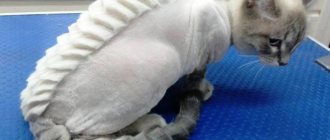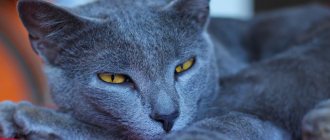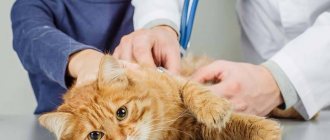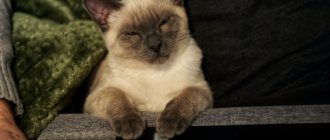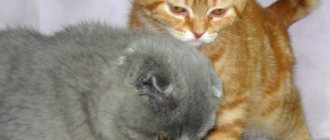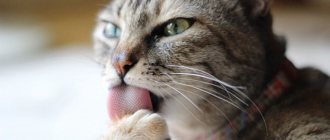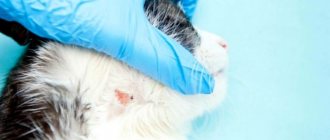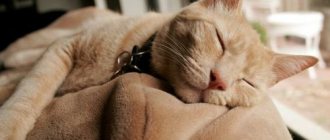Anastasia Dmitrievna Mitryaykina
veterinarian Petstory
Owners of cats are more likely than owners of other pets to encounter the problem of constipation, at which point the question of choosing a laxative for cats arises.
Constipation can be caused by a violation of the dietary regime, an unbalanced diet, or the ingestion of non-food elements into the intestines. Constipation in cats is accompanied by many serious diseases: liver and kidney diseases, injuries that make defecation painful.
Many cats that do not have serious systemic diseases may suffer from problems associated with stool retention. The reason for this is a sedentary lifestyle, violation of the drinking regime, a diet with a lack of fiber or, conversely, with its excess.
The psychological aspect for cats is very important: an inconvenient tray, an inappropriate filler, a toilet organized in a noisy place - all this can provoke stool retention, and constipation will form again.
Indications for the use of laxatives
There are quite a few causes for constipation in cats. It is necessary to take laxatives in the following cases:
- In cases where the main diagnosis is already known and medications are not given for the first time.
- Delay in defecation for more than 48 hours without pain or fever.
- In the treatment of skin diseases, after surgical interventions, when excessive tension is contraindicated for cats.
They resort to the help of laxatives before conducting a series of examinations (x-ray and endoscopic manipulations).
Only a doctor can determine which laxative a cat can use in different situations.
Overdose
Sometimes the pet owner may make a mistake in the amount of laxative or violate the time period. In this case, the cat shows signs of an overdose of Duphalac :
- loose stools, sometimes with the appearance of foam;
- lack of appetite;
- vomit;
- bloating;
- flatulence.
These symptoms are accompanied by increased anxiety in the pet. To eliminate the consequences of exceeding the dose of Duphalac, take smecta. If the animal's condition worsens sharply, contact a veterinarian.
Contraindications to the use of drugs
There are also situations in which the use of laxatives is strictly contraindicated:
- Lack of stool combined with painful attacks in the animal.
- Vague fever due to disturbance of bowel movements.
- Visible purulent lesions on the skin around the anus, genitals, or base of the tail.
- Vomiting with simultaneous absence of stool.
When constipation occurs for the first time, it is better to show your pet to a veterinarian to rule out serious organic pathology of the digestive organs (for example, intussusception, gastric volvulus, intestinal obstruction).
In the photo of a laxative for cats you can see that all manufactured drugs have detailed instructions with a list of contraindications.
When is papaverine used?
constipation: regulation of the physiological rhythm of colon emptying;
softening of stool for medical purposes (hemorrhoids, operations on the colon and anus);
hepatic encephalopathy - treatment and prevention of hepatic coma and precoma;
intestinal dysbiosis; enteritis caused by salmonella, shigella, salmonellosis in the stage of bacterial carriage; putrefactive dyspepsia syndrome (in young children as a result of acute food poisoning).
Group of bulk-forming drugs
Preparations in this group can be of plant or artificial origin. The most well-known representatives are Metamucil or flaxseed-based medications.
- All active components act in the intestinal lumen without being absorbed into the bloodstream.
- In the large intestine, the components of the drug actively accumulate water and dilute the pet’s stool.
- Due to greater pressure on the rectal sphincter, the act of defecation is stimulated.
Indications for the use of drugs include chronic constipation, exacerbation of hemorrhoids, anal fissures, functional constipation during cat pregnancy.
Osmotic laxatives
The second most frequently used group of drugs is osmotic drugs, the mildest laxative for cats. The main chemical component of these products is lactulose, which has a high osmotic pressure.
- In the large intestine, differences in osmotic concentrations of substances lead to the accumulation of water in the intestinal lumen.
- The principle is similar to the previous group of substances; the drug is also not absorbed into the pet’s body.
- The laxative effect develops slowly, up to 2 days after taking the drug.
- During the course of treatment, it is important to monitor your cat's drinking regime.
Modern drugs are available in a convenient form (powder or ready-made suspension), which makes taking the medicine easier. However, uncontrolled use invariably leads to loss of salts, glucose, and muscle weakness.
Release form and composition
The active substance of Duphalac is lactulose (66.7 g), diluted with distilled water (100 ml). Syrup with this composition is produced in the form of bottles of 200, 500 and 1000 ml. For the treatment of cats and cats, a minimum amount of product is sufficient. An analogue of the syrup is the powder of the same name in a foil sachet.
© shutterstock
Lubricants for cats
These drugs are widely used to remove hairballs, round-shaped foreign substances (only after X-ray examination), and for ulcerative colitis in cats.
The advantages of using these funds include:
- Convenient form of application (malt paste). The owner just needs to secure the pet, give it a paste-like mass, and wash it down with a small amount of water.
- The preparations contain only safe ingredients: petroleum jelly, fat-soluble vitamins A, E, D.
- Vaseline oil is absolutely not absorbed in the intestines, enveloping the walls of the digestive tract.
- Vitamins A and E have powerful restorative properties, which makes it possible to treat minor intestinal microtraumas in an animal.
- The Vaseline film formed on the intestinal wall prevents the absorption of any toxins or poisons into the bloodstream.
- Vitamin D is a stimulant of local immunity, which prevents the occurrence of intestinal infections.
In addition, it is convenient to calculate the drug per 1 kg of animal body weight, which is facilitated by the attached table of weight coefficients. This group belongs to fast laxatives for cats.
Are there any possible side effects?
If the owner follows all the specialist’s recommendations and gives the cat Duphalac in the prescribed dose, then no negative effects will be observed. When the dosage is exceeded or the medicine is given without taking into account possible contraindications, there is a high risk of complications, such as:
- prolonged diarrhea with foamy patches;
- nausea and vomiting;
- bloating;
- strong rumbling;
- increased muscle tone of the abdominal cavity.
If, after consuming Duphalac, your cat exhibits adverse reactions, then you should not delay your visit to the veterinary clinic. To stabilize digestive function, it is recommended to give the animal “Smecta” and other drugs of similar effect. In most cases, unpleasant symptoms in a cat after using Duphalac disappear after 2 days.
Laxative stool stimulants
The drugs in this group are strikingly different in their properties and chemical structure from other groups of medications. The active substance included in the medicine stimulates the muscles of the intestinal wall.
The result of the reaction is increased peristalsis of the large intestine. In case of an overdose of the drug, strong, very painful spasms of the smooth muscles of the digestive tract may occur.
Contraindications for the use of this group:
- Constipation in kittens whose intestinal muscle layer is underdeveloped and has a tendency to intussusception.
- Pregnant cats (the drug may cause miscarriage).
- Congenital organic malformations of the digestive tract (for example, short bowel syndrome).
With prolonged use, secondary lazy bowel syndrome often develops, in which stool without a laxative becomes impossible. For this reason, only a veterinarian can prescribe the drug and calculate the individual dosage.
Veterinarian review
Intestinal microflora is of great importance for the health of the animal. It can be disrupted due to stress, poor nutrition, and chronic diseases. As a result, constipation occurs. To help the animal defecate, it is not necessary to give an enema. I prescribe the gentle laxative Duphalac. However, it cannot be used often. This is fraught with digestive upset.
All information posted on the site is provided in accordance with the User Agreement and is not a direct instruction to action. We strongly recommend that before using any product, you must obtain a face-to-face consultation at an accredited veterinary clinic.
Treatment of constipation with folk remedies
If it is impossible to use industrial preparations, in the absence of severe organic pathology, you can use a laxative for cats at home:
- Pumpkin juice or boiled pumpkin are powerful stool stimulants for constipation. The development of the therapeutic effect is facilitated by the high content of plant fiber.
- Milk is the second most popular product that stimulates bowel movements. However, one should be aware of the common occurrence of lactose intolerance in felines.
- Flaxseed oil in its pure form perfectly loosens animal stool. As an alternative, olive and coconut oils are often used.
- Crushed sunflower seed husks not only stimulate intestinal motility, but are also a powerful sorbent. Can be used if food poisoning is suspected.
- For a number of congenital and metabolic diseases, laxative cat food (with a large amount of plant fiber) is used.
Oat bran or oatmeal decoction are widely used in home practice.
Such drugs form a coating of mucus and mucins on the intestinal walls, facilitating the passage of stool through the digestive tract.
How Duphalac works
After taking the drug, the following changes occur in the digestive system of pets::
- stimulation of intestinal motility, expressed in accelerating the movement of the food bolus;
- phosphates and calcium salts are absorbed faster;
- the absorption of toxic substances released as a result of constipation into the blood decreases;
- restoration of normal intestinal microflora;
- the concentration of lactobacilli, which neutralizes the acidic environment, increases.
A laxative for cats for constipation has a complex effect on the functioning of the gastrointestinal tract of animals. Duphalac helps to increase the volume and nature of feces, making it easier to remove waste products.
